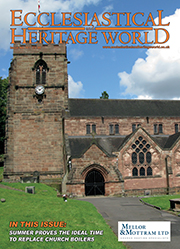Important ironwork set for conservation programme
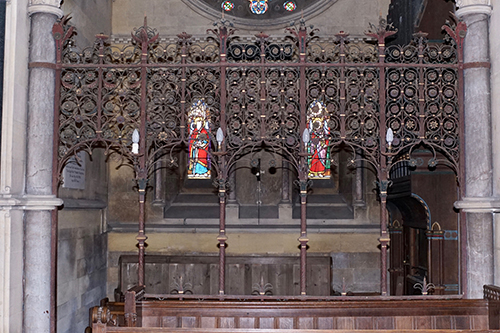 St Peter’s Church in Daylesford, Gloucestershire – close to Stow-on-the-Wold – is a Grade One-listed building and is now redundant, coming under the care of St Peter’s Daylesford Charitable Trust.
St Peter’s Church in Daylesford, Gloucestershire – close to Stow-on-the-Wold – is a Grade One-listed building and is now redundant, coming under the care of St Peter’s Daylesford Charitable Trust.
The present church building was designed by John Loughborough Pearson, a Gothic Revival architect, in 1859 and completed in 1863. Pearson had a long association with church architecture and was responsible for designing a large number of church buildings, including Truro Cathedral in 1880.
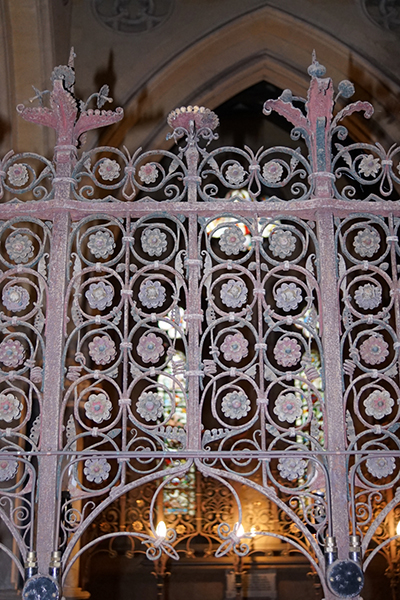
St Peter’s was built in a high gothic style – cruciform in plan with a pyramidal spire – of limestone with red sandstone features and stone slate roofs. There was use of mosaic marble, decorative floor tiles and ornate ironwork inside.
The ironwork included painted wrought-iron transept screens, altar railings and ornate wall lights. They are believed to be the work of Francis Skidmore, the very well-known craftsman and a leading figure in the Gothic revival movement. He is perhaps best known for the Hereford Screens now on display at the Victoria and Albert Museum. Pearson worked on a number of churches where decorative ironwork was used inside, several of which are recorded as being by Francis Skidmore.
No direct evidence has been found to confirm that the decorative ironwork to St Peter’s Church was that of Skidmore; however, its style, date of manufacture and Skidmore’s link to JL Pearson point to them being made at his Coventry factory.
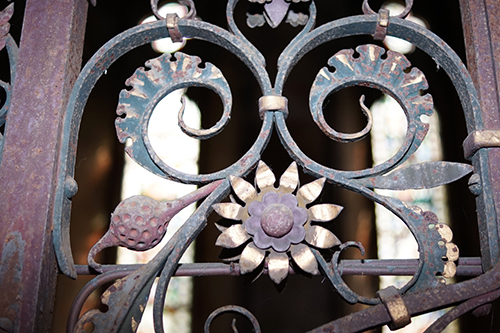 The church requires some conservation and repair to its fabric and Donald Insall Architects arranged for specialist surveys to be carried out in order to prepare for listed building consent. That included inspection of the painted transept screens and altar rail by specialist conservators Historic Metalwork Conservation Ltd.
The church requires some conservation and repair to its fabric and Donald Insall Architects arranged for specialist surveys to be carried out in order to prepare for listed building consent. That included inspection of the painted transept screens and altar rail by specialist conservators Historic Metalwork Conservation Ltd.
During the examination of the transept screens a number of stamp marks were found on the main iron uprights that appeared to be the letters SC and a crown. The latter was a stamp used to record the iron’s quality. Apart from the association of the ironwork to Francis Skidmore, it was also important because of its high quality and the fact that it retains its original paint finishes – from 1863. Those were examined separately by Helen Hughes of Historic Interiors Research and Conservation.
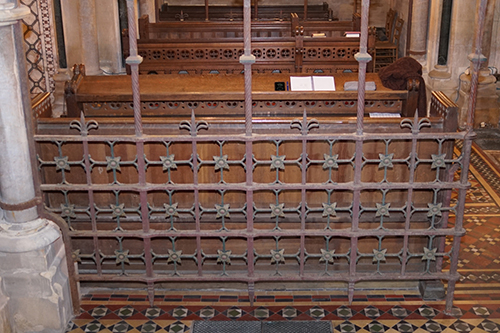 The two transept screens and altar rail were made from forged wrought-iron elements and finished using linseed oil-based paints, consisting of a red iron-oxide primer, light blue undercoat and coloured finish. Each screen was divided into five sections, or bays, by decorative iron uprights. A repeating screen sat at low level, divided up into small squares by criss-crossing bars. Set at the centre of each square was a decorative flower detail.
The two transept screens and altar rail were made from forged wrought-iron elements and finished using linseed oil-based paints, consisting of a red iron-oxide primer, light blue undercoat and coloured finish. Each screen was divided into five sections, or bays, by decorative iron uprights. A repeating screen sat at low level, divided up into small squares by criss-crossing bars. Set at the centre of each square was a decorative flower detail.
The detailing at high level was very ornate, with a series of high-level panels between each upright, all 10 being to a different design. Decorative elements were finished in dark reds, dark green, blue, yellow and purple – with gilding being used to highlight certain features to the nave side of each screen.
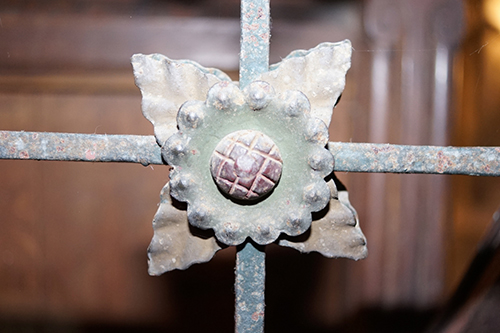 Although the ironwork was located inside the church building, and so was protected from the weather outside, there was little or no heating or environmental control inside. As a result the ironwork has been affected by condensation during colder months of the year. The original paint finishes were applied to provide protection to the ironwork and give it a decorative finish.
Although the ironwork was located inside the church building, and so was protected from the weather outside, there was little or no heating or environmental control inside. As a result the ironwork has been affected by condensation during colder months of the year. The original paint finishes were applied to provide protection to the ironwork and give it a decorative finish.
The coatings are now very old and have degraded. Moisture has managed to penetrate through flaws in the paint layers to the iron beneath, leading to small areas of corrosion and rust formation. In addition, as the church is no longer in regular use there has been no recent cleaning of the iron transept screens, which had accumulations of dust and dirt present.
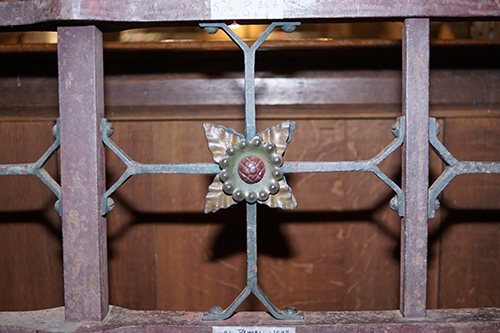 After an initial condition survey of the transept screens and altar rail, proposals were put together for the conservation of this very important ironwork. As a first stage, it was agreed to carry out some cleaning and conservation trials to see how well the ironwork could be cleaned, and to look at options to consolidate the deteriorated paint layers and treat localised rust patches.
After an initial condition survey of the transept screens and altar rail, proposals were put together for the conservation of this very important ironwork. As a first stage, it was agreed to carry out some cleaning and conservation trials to see how well the ironwork could be cleaned, and to look at options to consolidate the deteriorated paint layers and treat localised rust patches.
A small section of one of the lower screens was selected for the trials. It was initially dry-cleaned using conservation brushes and a vacuum cleaner. The painted surfaces were then wet-cleaned with distilled water and 1% TritonX100 non-ionic detergent, applied using cotton wool swabs rolled across the surface. Small rust blisters and areas of loose rust were carefully removed under magnification using a scalpel blade and a fine glass bristle brush back to a sound surface.
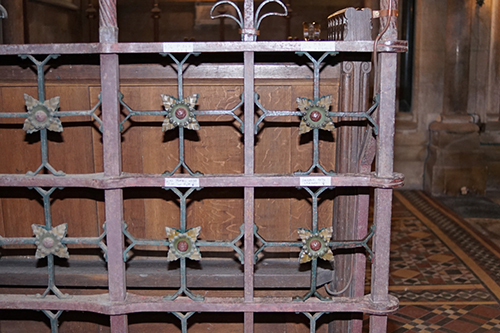 Four different potential consolidants were tried, to identify which would be the most suitable to both consolidate the paint layers and enhance the overall colour, which had dulled with age. They included a 5% solution of Paraloid B72, a 5% solution of Paraloid B67 (both acrylic resins), Primal WS24 and Lascaux 4176 (both acrylic dispersions in water).
Four different potential consolidants were tried, to identify which would be the most suitable to both consolidate the paint layers and enhance the overall colour, which had dulled with age. They included a 5% solution of Paraloid B72, a 5% solution of Paraloid B67 (both acrylic resins), Primal WS24 and Lascaux 4176 (both acrylic dispersions in water).
The decorative flower on the lower panel was chosen, so the finish of each could be compared directly. Two coats were applied, allowing the first to dry before the second was applied. A visual assessment suggested that the 5% Paraloid B67 in white spirit gave the best results.
A report was prepared for the client, with final recommendations for the conservation of the church ironwork.
For further information visit www.hm-cc.uk











